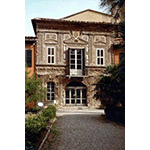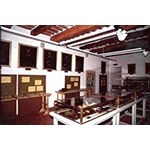Museo Botanico dell'Universitą degli Studi di Pisa [University of Pisa Botanical Museum]
A "Gallery" or Museum of Natural History, also containing plant specimens, was instituted at Pisa's Botanical Gardens around 1591 at the initiative of Grand Duke Ferdinand I de' Medici, who contributed to enriching the collections with rare, precious pieces, in keeping with the taste of the time. Today, only a few rooms of the sixteenth-century museum remain, reached through the Botanical Gardens, while the surviving materials are kept in the Museo di Storia Naturale at Calci.
Towards the end of the 18th century the organisation of today's Botanical Museum was begun, thanks to the commitment of Gaetano Savi, Professor of Botany and Director of the Gardens until 1842. At present the Museum contains plant specimens and collections of plants gathered from the time of its origin for the purpose of study and as teaching aids. Specifically, the General Herbarium is formed of university collections dating from the 18th century to the present, while other Personal Herbariums, consisting of the collections of several different botanists, were acquired by the university from the late 19th century to around 1960. Three other collections are noteworthy: the wood collection, with longitudinal and cross sections of various arboreal species; the collection of plant samples including those of fruit, flowers, inflorescences and seeds; the collection of fossils coming from Tuscany and Lazio, dispersed during World War II and found again in the 1990s.
Also interesting are the wax models of fruits, macroscopic fungi [non si usa anche in inglese "macromycetes" per macromiceti?] and anatomical parts of various plants, made in the period 1830-1840 by the famous Florentine wax modeller Luigi Calamai, and the educational plates, consisting of large panels with pencil or ink drawings, and occasionally water-colours, accomplished mainly by Enrico Cristofani in the second half of the 19th century.
The Museum shares with the Botanical Gardens a Library and Archives, kept at the rich Library of the Department of Botanical Science.
****************************
Texts by Francesco Marchetti
English translation by Catherine Frost
Last update 11/feb/2008





